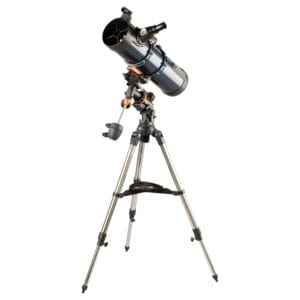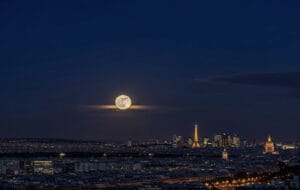We receive the question how to choose a telescope almost daily. And rightfully so. You want to see the moon’s craters in detail, admire Saturn’s rings, or maybe even observe a galaxy. But as soon as you search online, you encounter a maze of specifications, claims, and models.
Many beginning stargazers get lost. Terms like “625x magnification”, “deep-sky capable” or “includes 3x Barlow lens” sound impressive – but often say little about actual performance. In this guide, we’ll help you see through the marketing jargon and discover what really matters when choosing the right telescope.
Why Magnification is a Poor Measure
Most people look for a telescope with “high magnification”. Logical, as you might think more magnification means seeing more. But that’s a misconception.
In reality, the aperture determines how much light enters. And light is everything. Without sufficient light, you won’t see anything – no matter how much you zoom in.
✓ More magnification doesn’t automatically mean more detail
✓ A blurry image at 100x remains blurry at 300x
✓ Too much magnification results in dark, shaky images
How to Choose a Telescope: Maximum Usable Magnification – a Guideline
The rule of thumb is simple:
Maximum magnification = 2x the diameter of the lens or mirror in millimeters.
Examples:
- 70 mm telescope → maximum usable magnification: 140x
- 102 mm telescope → maximum usable magnification: 200x
- 150 mm telescope → maximum usable magnification: 300x
Note: this is the upper limit. The best images are often obtained at magnifications between 50x and 150x, depending on your target (moon, planets, deep-sky).
What You should Actually Consider when Choosing a Telescope
1. What Do You Want to See?
Not every telescope is suitable for every type of observation. Start with a clear choice:
✓ Observing the Moon and planets:
Choose a telescope with a longer focal length (700 mm or more) and good optics. This allows you to see more detail with sufficient contrast.
Recommended: Celestron StarSense Explorer, Bresser Dobsonian 130/650
✓ Deep-sky objects (nebulae, galaxies):
You need a larger aperture (minimum 130 mm, preferably 150 mm+) to provide enough light for faint objects.
Recommended: Omegon Dobsonian 203/1000, GSO Dobson 200/1200
✓ All-round use:
Want to observe both planets and deep-sky objects? Then a Dobsonian of 130 to 150 mm is often the best choice.
Recommended: Celestron StarSense Explorer Dobsonian, Omegon Push+ mini 150/750
📍 Use our stargazing guide for help with choosing.
2. Aperture is more Important than Magnification
A larger aperture means more light intake, and thus a brighter, sharper image. That makes more difference than any magnification.
Compare:
- 80 mm with 160x magnification = bright image with detail
- 50 mm with 400x magnification = dark and blurry
Therefore, always look at the diameter of the lens or mirror first (for example 70 mm, 102 mm, or 150 mm).
✓ More aperture = better image
✓ Combine with good eyepieces for maximum performance
3. Avoid Telescopes with Misleading Claims
Many webshops (especially marketplaces like bol.com or Amazon) advertise entry-level models with:
- “600x magnification!”
- “3x Barlow lens included!”
- “Ideal for deep-sky!”
In practice:
✗ A cheap telescope with 600x magnification is often unusable
✗ 3x Barlow lenses are usually added to inflate numbers
✗ Deep-sky observation isn’t possible with a 60 mm telescope
A good product sells itself without exaggeration. Choose transparency and proven performance.
Smart Telescopes as an Alternative
More and more smart telescopes are entering the market that automatically find objects and focus. Consider models like:
- Seestar S50: compact, fully automated, suitable for deep-sky and planets
- DWARF 3: ideal for astrophotography with wide field of view
- Vespera II: high-quality AI telescope with superior image quality
These models are especially interesting if you have little experience but want to see a lot – without the hassle.
📍 Read our astrophotography buying guide if you want to photograph.
Common Mistakes when Buying a Telescope
✓ Using magnification as the starting point
✓ Not considering the aperture
✓ Buying from non-specialized sellers
✓ Not accounting for intended use (visual or photography)
✓ Forgetting that stability and mounting are as important as optics
At Telescoop.nl, we help you avoid falling into these traps. Our models are selected for quality, durability, and practical usability.
Conclusion: how to Choose a Telescope?
Choosing a good telescope starts with understanding what you want to observe and which optics best suit that purpose. Don’t be tempted by spectacular numbers, but look at:
✓ Aperture (minimum 70 mm for moon and planets, 130+ mm for deep-sky)
✓ Optical quality (coatings, finish, eyepieces)
✓ Stable mounting (preferably a Dobsonian or robust tripod)
✓ Realistic magnification (maximum 2x the aperture)
✓ Credible information from a specialist
📍 Check our buying guide for personal recommendations
📍 Or filter directly in our product catalog based on your needs








